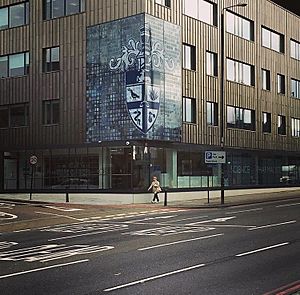Royal Pharmaceutical Society facts for kids
 |
|
| Abbreviation | RPharmS, RPS |
|---|---|
| Predecessor | Royal Pharmaceutical Society of Great Britain |
| Established | September 2010 |
| Headquarters | East Smithfield London, E1 |
| Location | |
|
President
|
Claire Anderson |
|
Chief executive
|
Paul Bennett |
| Website | rpharms.com |
The Royal Pharmaceutical Society (RPS) is a group that supports and leads the pharmacy profession in England, Scotland, and Wales. It was created in September 2010. Before that, there was one big group called the Royal Pharmaceutical Society of Great Britain. This group was split into two: the RPS and the General Pharmaceutical Council (GPhC). This split happened so that one group could focus on supporting pharmacists, and the other could focus on making rules and checking that pharmacists follow them.
You don't have to be a member of the RPS to work as a pharmacist in the United Kingdom. The original group, the Pharmaceutical Society of Great Britain, started a long time ago, on April 15, 1841.
Contents
A Look Back: History of the RPS
The Royal Pharmaceutical Society began on April 15, 1841. It was first known as the Pharmaceutical Society of Great Britain. Its first main office was in London. Some of the people who helped start it were Jacob Bell and William Allen.
In 1843, the Society received a special "royal charter." This charter meant its main goals were to improve chemistry and pharmacy. It also aimed to create good education for pharmacists. Plus, it worked to protect its members legally.
Where is the RPS Headquarters?
The main office of the Royal Pharmaceutical Society is in London. It's on East Smithfield Road, close to areas like Whitechapel and St Katharine Docks. For many years, from 1976 to 2015, the RPS headquarters was in a different part of London called Lambeth.
Joining the Society: Membership Types
The Royal Pharmaceutical Society offers different ways for people to join. Here are the five main types of membership:
- Member: If you have ever been a registered pharmacist in Great Britain, you can become a full member. It doesn't matter if you are currently working as one.
- Fellow: This is a special honor. Pharmacists who have been members for at least 12 years can become Fellows. This happens if they have done amazing and important work in pharmacy.
- Associate: This type of membership is for two groups of people. First, it's for pharmacists who are registered in other countries but not in Britain. Second, it's for those who have a pharmacy degree but haven't yet registered as a pharmacist in Britain. This might be because they are still training.
- Student: If you are studying to get a pharmacy degree, you can join as a student member. This applies whether you are studying in Britain or another country.
- Pharmaceutical Scientist: This membership is for people with a degree in a subject related to pharmacy. They also need to have worked for at least two years in pharmaceutical sciences.
Leaders of the Society: Presidents
The Royal Pharmaceutical Society has a President who leads the organization. Here are some of the recent Presidents:
- 2021: Claire Anderson
- 2019: Sandra Gidley
- 2017 – 2019: Ash Soni
- 2016 – 2017: Martin Astbury
- 2014 – 2016: Ash Soni
What the RPS Publishes
The Society has two parts that publish books and journals:
- The Pharmaceutical Press creates textbooks. These books cover many topics in pharmacy and pharmaceutical science. Some well-known books include the British National Formulary, the British National Formulary for Children, and Martindale: The complete drug reference.
- PJ Publications publishes two important journals. One is The Pharmaceutical Journal, which comes out every week. The other is Clinical Pharmacist, published once a month.
Exploring Pharmacy History: The RPS Museum
The Royal Pharmaceutical Society has had a museum collection since 1842. This collection is still looked after by the RPS at its London office. The museum shows the history of pharmacy in Britain.
Here are some things you can see at the museum:
- Old tools used for mixing medicines.
- Containers for storing drugs.
- Beautiful old pottery from the 17th and 18th centuries.
- Brand-name medicines from the 1700s to today.
- Bronze mortars, which are bowls used for grinding.
- Funny drawings about medicine.
- A collection of old photos.
Since 2002, the museum has focused on collecting old and new brand-name medicines.
You can visit the museum for free. If you want a guided tour, you can book one ahead of time. In 1983, the Society gave over 10,000 old plant and drug samples to Kew Gardens. These are now part of Kew's collection. The museum is also a member of the London Museums of Health & Medicine.
Awards and Honors from the RPS
The RPS gives out six different awards to pharmacists. These awards recognize pharmacists at various stages of their careers.
- The Hanbury Medal
- The Harrison Medal
- Outstanding Pharmacy Early-career Researcher Award
- RPS Charter Medals
- RPS Fellowship and Honorary Fellowship
- The Daniel Thomas Award
National Pharmacy Boards
There are three special boards that help lead and support pharmacy in England, Scotland, and Wales. Each board has a chairperson. Currently, these are Thorrun Govind for England, Andrew Carruthers for Scotland, and Cheryl Way for Wales.
Members of these boards are chosen by the members of the Society. There is also a larger group called the Assembly. The Assembly makes important decisions and policies for the Society.
See also
- Pharmaceutical industry in the United Kingdom
- List of pharmacy organizations in the United Kingdom
- List of schools of pharmacy in the United Kingdom
- British National Formulary
- The Pharmacy Practice Research Trust


